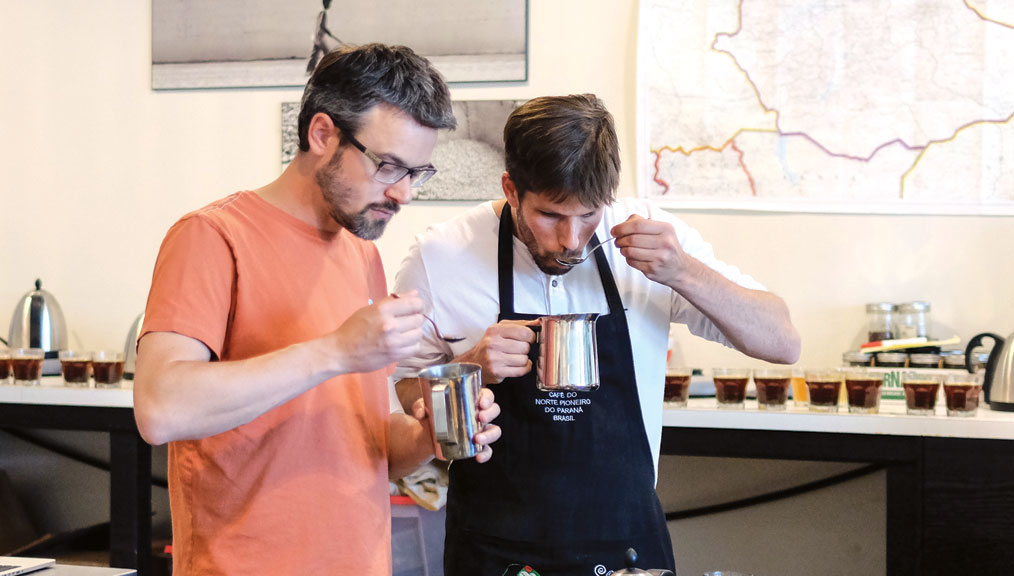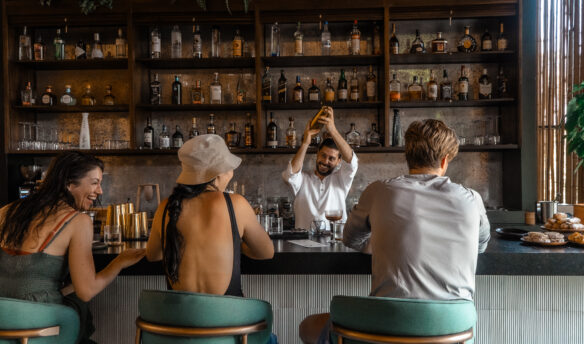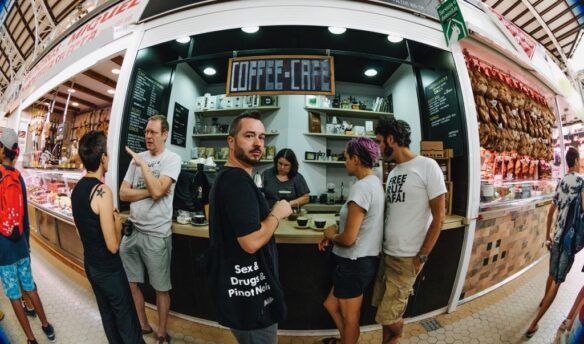In early 2009, two years after we opened our first café, we were about to launch our roasting business. We’d heard rumors of the remarkable coffees of Scandinavia and decided that in the interest of sculpting our roasting style, a research trip to experience them firsthand was the only responsible course of action. It would also be a tasty one.
In Norway, we visited the illustrious Tim Wendelboe café. The coffees we tried were the lightest roasts we had ever tasted but still fully developed and completely delicious. We admired his ability to achieve full flavor without introducing carbon or ash notes and committed to doing the same.
As chance would have it, we shared the same roasting machine (a Probat UG15), and we were confident that, in time, we would be able to roast in this style.
Taking Lessons Home
We returned to Calgary eager to knock some light roasts out of the park.
We failed. Then we failed some more. Finally, after the better part of a year, we had our roasting in a decent place, and we arranged with Tim to do a coffee swap. It’s worth mentioning that at the time (according to our tastes), we were far and away the lightest roasters in Canada and the better part of the US as well. 
Then came the feedback from Tim. He was thoughtful and thorough with his review of our coffees but ultimately indicated that, for him, they were dominant in carbon and ash flavors. While disappointed, I chalked this up to his superior taste buds and forged ahead to develop mine further.
In 2011, Sebastian and I visited Oslo for the second time. This time, we brought coffee with us, and we arranged in advance to meet and cup with Tim at his café and roastery. It would be redemption.
A Second Chance
I put enormous rigor into the roasts. I selected our best green, and I spent months building profiles. On the day of the final roasts, every second of data in my profiles tracked exactly (using custom roast-logging software I had written), and I cupped them numerous times. The coffees were awesome! I even packed them in a second five-pound coffee bag, without a valve, to protect the coffee from the low pressure of the plane cabin. I was ready.
When we arrived at Tim’s place, I gave him the coffees, and he prepared a cupping with three of our coffees and eight others unknown to us.
Sebastian and I cupped through the table of coffees and tasted some extremely ash-heavy coffees, so ashy that all origin was masked. I also noticed some “kind of” ashy coffees with little origin character; then, I noted some delicious, sweet, nuanced, and balanced coffees. I knew our coffees well but couldn’t identify them and was filled with dread.
We revealed the coffees, and to my slight relief, the very ashy coffees didn’t belong to us, but to my dismay, our coffees were the moderately ashy ones with very minimal origin. The most vibrant and balanced coffees were Tim’s.
I was embarrassed and discouraged. I didn’t sleep well that night. My thoughts raced with plausible explanations. Did travel, despite my precautions, still damage the coffee? Was it related to relative humidity or altitude in some inexplicable way? I knew a reasonable amount about water at the time.
I studied some basic water chemistry, used titration tests, and even worked with a local laboratory to test and tune our water. Nevertheless, at the time, I didn’t even consider water as a reasonable cause for the discrepancy between the bright, vibrant, origin-trumpeting coffees I tasted in Calgary and the dull, roasty, generic coffees on the table in Oslo.
A Revealing Variable
Fast-forward to 2014. We were honored to receive an invitation from Tim to submit samples for a cupping that he would use to select sponsors for the MAD Symposium, an event held in Copenhagen about the future of food. This event was a big deal. The MAD Symposium was founded by the legendary chef René Redzepi of Noma, considered at the time to be the best restaurant in the world.
In the back of my mind—check that—at the front of my mind, I thought, “What’s the point? Our coffees are going to taste like ash bombs there.” However, I simply couldn’t pass up a good challenge, so Sebastian and I agreed to send samples.
Based on how ashy our coffees had tasted in Oslo, I knew we would have to roast the coffee lighter than our average roast level. But I still wasn’t sure how to establish a benchmark to ensure the coffee was adequately developed and didn’t just taste grainy and generic, as under-roasted coffee does. It was like trying to navigate the ocean without a map or compass.
Before roasting and sending the samples for MAD, Sebastian and I headed to Rimini, Italy, for the 2014 World Barista Championship. One of the Phil & Sebastian baristas was representing Canada, and we tagged along as coaches.
It was in Rimini that I met Maxwell Colonna-Dashwood, and we clicked immediately. It turns out that he has a passion for water and knowledge that well surpassed mine. After I returned home, my interest in water for coffee was rekindled, and I resumed my research.
It was then that I started to formulate a theory. What if the fundamental difference between how our coffees tasted in Calgary versus Oslo was simply because of water?
Blocked By Bicarbonate
I knew Oslo had naturally soft water, but I didn’t know the specific composition, so I inquired with Tim. He gave me a little to go on, and I scrounged the rest of the detail from the Municipality of Oslo website.
All of the nice, bright, fruity acids we carefully elicited from our coffees were blocked by a wall of bicarbonate.

After some number crunching, I noticed that our calcium and magnesium amounts were comparable, but Oslo’s bicarbonate content was over twice as high. Bicarbonate buffers our perception of acids in coffee. All of the excellent, bright, fruity acids we carefully elicited from our coffees were blocked by a wall of bicarbonate. (Chris Hendon goes into more detail about this in his article.)
After a bit more math, some baking soda, and a colorimeter to test carbonate hardness, I manufactured some Oslo-like water in our Calgary cupping lab. I proceeded to taste our coffees with this concoction, and low and behold, they tasted ashy and flat. I’d never been happier tasting bad coffee.
The next logical step was to tune the roast profiles for our top coffees to this new water. I worked through many profiles over the next few weeks, and slowly but surely, I managed to get the coffees to perform with my Oslo water.
The time came to send in the samples, and I waited impatiently for the results of the sample cupping. On July 15, I got the news. We made it! One of our coffees performed very well, and we were selected as a silver sponsor for the event. I was elated and relieved that my nemesis—Oslo’s bicarbonate-packed water—had been thwarted.
On that day, I understood a fundamental of coffee roasting: all roasters roast to their own water, whether they realize it or not. The outcome of this experiment opened a chasm of new challenges. Should we attempt to custom-roast our coffee to our wholesale customers’ water? Or should we be promoting water standardization? Is that even feasible on an international scale? And what would that standard be?
I have more questions than answers presently, but the numerous unknowns in the still-adolescent industry of specialty coffee is what keeps me hooked.
Phil Robertson is the co-founder of Phil & Sebastian Coffee Roasters in Calgary, Alberta.
This article was originally published on July 5, 2016 and has been updated to meet Fresh Cup’s current editorial standards.

















